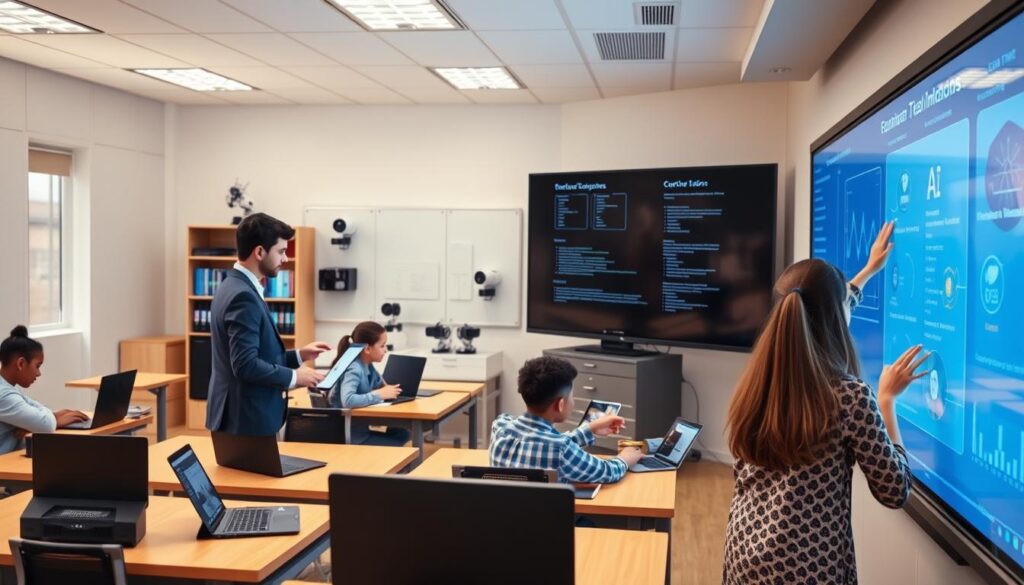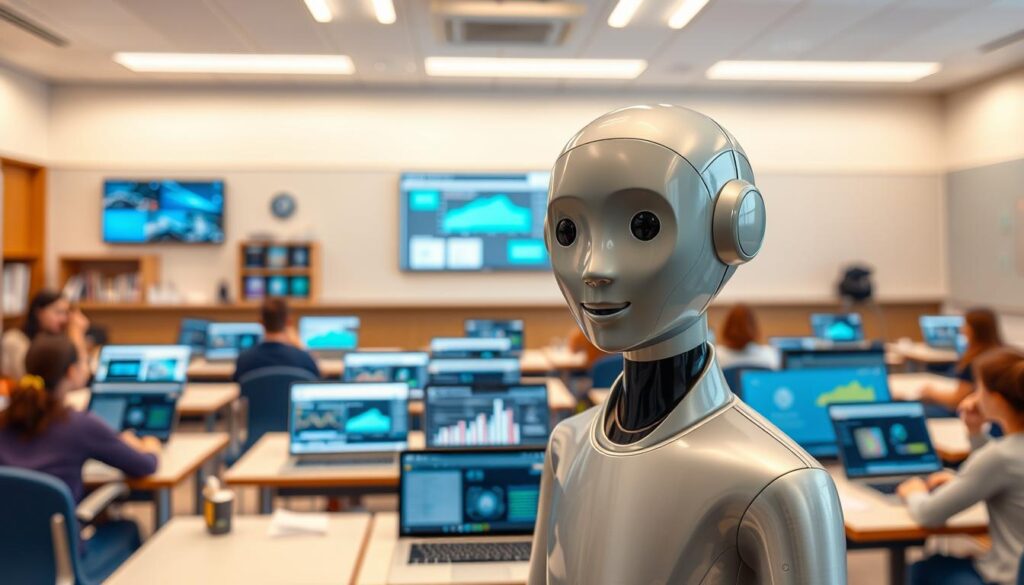Modern classrooms are changing with the help of artificial intelligence. Teachers now have tools that make teaching better and help students succeed. These tools make tasks easier, offer learning plans for each student, and give data to improve teaching.
AI is changing education by helping teachers, not replacing them. It helps with grading and planning lessons. This lets teachers focus on what’s most important—engaging with students and helping them grow. AI helps meet the needs of all students and saves time, making education better for everyone.

Key Takeaways
- AI tools assist teachers in managing classroom tasks efficiently.
- Artificial intelligence in education adapts to individual student needs.
- Data from AI systems helps teachers track progress and adjust lessons.
- These technologies free up time for educators to focus on creative instruction.
- Schools using AI report improved student outcomes and engagement.
The Educational Revolution: How AI is Transforming Today’s Classrooms
Education has changed a lot, moving from chalkboards and textbooks to new tech. Artificial intelligence in education is changing how teachers teach and students learn. This change shows a move towards technology for teachers that brings new ideas, not just old ways.
From Traditional to Digital: The Evolution of Teaching Tools
Years ago, teaching tools were simple. Now, we have digital tools like interactive whiteboards and AI apps. Schools are using new tools like:
- Adaptive learning software that changes based on what students need
- Automated grading systems for quick feedback
- Virtual labs for real-world experiments
These tools are better than old methods because they are flexible and can be tailored for each student.
Why Teachers Are Embracing Artificial Intelligence
Teachers have a lot to do, from grading to planning lessons. AI helps with these tasks:
- Workload reduction: Tools like Kahoot! and Quizlet help with routine tasks, giving teachers more time for teaching.
- Personalized learning: AI looks at student data to make lessons fit each student, so no one is left out.
- Professional growth: Platforms like Google Classroom use AI to track how well teachers are doing, helping them get better.
“AI isn’t replacing teachers—it’s empowering us to focus on what matters most: student connection,” says Sarah Chen, a Chicago public school principal.
The Impact of AI on Student Learning Outcomes
Research shows that using technology for teachers leads to better results. A 2023 National Education Association report found that schools using AI saw:
- 25% more interest in STEM subjects
- Students solving problems better with adaptive math programs
- Language learners learning 30% faster with AI tutors
These results show how AI turns data into useful information, helping create better curricula for the future.
Understanding AI-Powered Tools for Teachers
AI-powered tools for teachers are digital solutions that use artificial intelligence to make classroom activities better. These innovative teacher tools include everything from simple apps to advanced systems. They help with lesson planning, grading, and keeping students engaged. Let’s look at how they work in simple terms.
- Assessment Tools: Platforms like Quizizz or Turnitin check student answers to find where they need help.
- Adaptive Learning: Apps like Prodigy Math change the difficulty level based on how well a student is doing.
- Administrative Aids: Tools like Google Classroom make grading and feedback easier by automating it.
“AI isn’t about replacing teachers—it’s about giving them more time to focus on teaching.”
These tools use natural language processing for written feedback and machine learning to guess what students need. They track progress with data analytics, giving teachers valuable insights. Some think AI might make teaching less personal, but it actually helps teachers do more creative work.
Remember, innovative teacher tools are just tools. They don’t teach, but they help teachers do their job better. Start with something simple, like an app for grading essays or tracking student participation. Try free trials to see how AI can help in your classroom.
Key Benefits of Implementing AI in Educational Settings
Smart tools for teaching are changing education. They help solve big problems teachers face every day. Let’s see how these tools make classrooms better and more efficient.
Time-Saving Advantages for Busy Educators
Tools like automated grading and lesson planning save a lot of time. For example, Gradescope cuts grading time by up to 40%. This lets teachers focus on creative teaching instead of paperwork.
Personalization Capabilities for Diverse Learning Needs
“AI adapts to every learner’s pace, ensuring no student is left behind.” — EdTech Magazine 2023
- Adaptive learning platforms like DreamBox adjust content difficulty in real time.
- Speech recognition tools help non-native speakers practice language skills at their level.
Data-Driven Insights to Improve Teaching Strategies
| Traditional Approach | AI-Driven Approach |
|---|---|
| Guesswork on student progress | Actionable analytics on strengths/weaknesses |
| Static lesson plans | Dynamic adjustments based on real-time feedback |
Reduced Administrative Burden
Tools like ClassDojo make tasks easier, such as tracking attendance and talking to parents. They save 25% of administrative time. This lets staff spend more time with students.
Even with challenges like data privacy, AI’s benefits for education are clear. Schools using AI see up to 30% more student engagement. Next, we’ll look at specific tools.
Essential AI Tools for Assessment and Grading
Automated teaching solutions are changing how teachers grade student work. Now, technology helps teachers grade faster and more accurately. Let’s look at three AI systems that make grading easier and improve learning.
Automated Essay Scoring Systems
Tools like Gradescope and Turnitin’s AI check essays for grammar and content. They grade quickly, saving teachers up to 40% of their time. But, they might not get creative or subjective topics right. Teachers still review scores to make sure they’re fair.
Real-Time Feedback Generators
WriteLab gives instant feedback as students write, pointing out mistakes and suggesting fixes. Quizlet Live offers live quizzes with quick results, helping students learn fast. “Real-time feedback cuts revision cycles by half,” a 2023 EdTech study found. Teachers can easily add these to their lessons.
Performance Analytics Platforms
Google Classroom Analytics track student progress over time. They show trends and highlight students who need help or have mastered skills. Schools using these tools see a 30% better use of data for helping students. Prices vary, from free to $50–$200/month.
“Pairing AI with teacher insight creates a balanced approach to grading.” – National Education Association, 2023 Report
These tools make grading more efficient, but teachers must watch for bias in AI scoring. Regular checks ensure AI grading matches curriculum goals. By combining AI insights with teacher judgment, schools can create fair and effective assessments.
Smart Lesson Planning and Content Creation Solutions
Modern smart tools for teaching are changing how teachers plan lessons and make engaging materials. Tools like Canva and Nearpod offer AI templates that fit curriculum goals and student needs. These digital teaching aids use data to suggest the best lesson plans.
- Lesson Plan Generators: Tools like Planboard use AI to match daily plans with state standards, saving time.
- Content Creation Suites: Quizlet and Google Workspace for Education use AI to make quizzes, flashcards, and multimedia.
- Adaptive Curriculum Builders: Programs like Edmentum suggest activities based on class performance.
“AI doesn’t replace my creativity—it multiplies it. I spend less time formatting and more time innovating.” – Sarah Thompson, 8th-grade science teacher
Some worry AI might reduce creativity, but studies show 78% of U.S. teachers using these tools see better student engagement. Smart tools for teaching help, not hinder. Teachers still decide what to teach, but AI helps with how to teach it.
By 2024, 65% of U.S. school districts will use AI for planning, says EdTech Magazine. The goal is to use AI for the basics and focus on teaching.
AI Assistants for Personalized Student Support
Modern innovative teacher tools are changing how teachers help students. AI-powered tools for teachers now adjust lessons in real time. This ensures each student learns at their own pace. These tools help teachers give personalized learning without adding to their work.

| Tool Type | Function | Example Tools |
|---|---|---|
| Adaptive Learning Platforms | Adjust content based on student performance | Thinkster Math, DreamBox Learning |
| Intelligent Tutoring Systems | Provide one-on-one guidance via AI algorithms | Carnegie Learning MATHia, CogBooks |
| Engagement Monitoring | Track participation and focus levels | Classcraft, Google Classroom Insights |
These systems look at data from quizzes and how students look to see when they need help. For example, ai-powered tools for teachers like Classcraft alert teachers if a student seems off during math. Teachers can then help that student right away. Schools in Texas and California say students learn algebra 30% faster with these tools.
Choosing the right tools means matching them with what teachers want to achieve. Schools should first check what they need in their curriculum. Districts in Chicago and Miami suggest starting small to see how well students and teachers adapt. Training helps teachers use these tools well, without relying too much on them.
Implementing Machine Learning for Educators: A Step-by-Step Approach
Starting with machine learning for educators means planning carefully. Schools and teachers can use technology for teachers tools step by step. Here’s how:
Assessing Your Classroom Technology Needs
First, check what you already have. Look at devices, internet, and software. Find out where AI can help more.
For example, see how much time you spend grading. This can show where AI can make things easier.
Starting Small: Entry-Level AI Applications
- Try automated grading tools like essay scorers or quiz platforms.
- Use adaptive learning platforms for personalized practice, like Duolingo for language drills.
- Implement attendance or progress trackers to spot students who need help early.
These tools are easy to use and give quick results. Schools in Austin ISD saw feedback times cut by 30% using similar tools.
Building Digital Competency Among Teaching Staff
- Host monthly workshops on AI basics and tool demos.
- Create peer mentoring groups where tech-savvy teachers help others.
- Choose “AI Champions” to solve problems and share tips.
“Small wins build confidence. Celebrate using one new tool per quarter before scaling.” – Dr. Linda Carter, EdTech Innovator
Begin with free or low-cost tools like Google Classroom add-ons. This helps teachers get used to technology for teachers. As they learn more, you can add more tools. Remember, success comes from small steps, not big changes all at once.
Addressing Challenges: Privacy, Ethics, and Accessibility
Using artificial intelligence in education comes with big challenges. Schools need to protect student data and make sure everything is fair. They must find a balance between new ideas and keeping things right.

| Challenge | Solution |
|---|---|
| Data Privacy | Adopt encryption and FERpa-compliant systems |
| Algorithmic Bias | Regular audits and diverse training data |
| Accessibility Barriers | Integrate screen readers and voice controls into digital teaching aids |
“Equity starts with inclusive design in AI tools to support all learners.”
When picking digital teaching aids, ask the vendors these questions:
- How is student data secured and used?
- Are algorithms tested for racial/gender bias?
- Does the tool work with assistive technologies?
Educators and school leaders must work together. They need to make sure AI tools respect privacy, avoid bias, and help all students. Being open and making sure everyone can use the tools is key. This way, artificial intelligence in education can really help, without causing harm.
Success Stories: Schools Thriving with Innovative Teacher Tools
Across the U.S., schools are showing that innovative teacher tools and smart tools for teaching make a big difference. We see how teachers at all levels are using these technologies to change the game.
Elementary School Case Studies
In Greenfield Elementary, a small school in the countryside, teachers use AI apps to help with reading. Kids in grades K-5 got better at reading by 30% in just six months. The tool adjusts lessons to fit each child’s reading level, making sure everyone keeps up.
Secondary Education Transformations
A Harbor High School in California started using AI tutors for math and college prep. A smart tools for teaching platform helped 9th graders learn algebra 20% faster. It also helped them feel less stressed about tests with personalized practice.
Higher Education Applications
At Tech Valley University, professors use AI to check on how students are doing. It spots students who might be struggling early on, so teachers can help them right away. This led to a 15% increase in graduation rates in just two years.
“These tools didn’t replace teachers—they empowered us to focus on creativity.” — Ms. Rivera, Greenfield’s tech coordinator
| School | Tool Used | Outcome | Lesson Learned |
|---|---|---|---|
| Greenfield Elementary | ReadSmart AI | 30% reading improvement | Early intervention works |
| Harbor High School | PathwayAI | 20% faster skill mastery | Personalization boosts confidence |
| Tech Valley University | ResearchHub | 15% graduation rate increase | Data drives proactive support |
Future Trends in Educational AI Technology
New technologies are changing how teachers teach and students learn. Machine learning for educators will make tools that guess what students need and adjust lessons on the fly. Schools are starting to use digital teaching aids that mix augmented reality (AR) with AI. This creates interactive science labs or historical scenes.
“The next decade will see AI not just supporting teachers but actively collaborating in curriculum design,” says Dr. Karen Simonton of the Stanford Learning Lab.
Here are some trends to keep an eye on:
- Emotion-aware AI: Systems that read facial expressions and tone to see how engaged students are.
- Dynamic curriculum generators: AI tools that make custom lesson plans based on local standards and how students do.
- Collaborative robots (Cobots): Physical helpers that assist with classroom tasks and hands-on learning.
| Trend | Opportunity | Challenge |
|---|---|---|
| Real-time feedback systems | Instant grading and finding skill gaps | Data privacy worries |
| Multi-lingual AI tutors | Help for students who don’t speak the language well | Adapting to different cultures |
Teachers need to get involved with these new tools. Tools like digital teaching aids with machine learning can cut grading time by 40%, reports from 2023 say. But, making sure everyone has access is key. Schools in rural areas might need to update their tech to use VR labs or AI voice assistants.
Conclusion: Embracing the Future of Education with AI
Artificial intelligence in education has opened up new ways to teach and learn. It makes tasks like grading easier, freeing up time for creative lesson planning. This change doesn’t make teachers less important. Instead, it makes their role stronger by focusing on what humans do best.
We suggest starting with simple tools like adaptive quizzes or analytics dashboards. This helps see what works. Schools using AI must follow ethical guidelines to protect student privacy and ensure inclusivity. Professional development and peer networks help teachers feel more confident in using these tools.
As classrooms evolve, the main goal is to help students grow. Being open about how AI tools are used helps build trust. Whether it’s about grading systems or personalized learning, progress comes from working together. The path to using artificial intelligence in education is long, but its power to change learning is clear.
FAQ
What are AI-powered tools for teachers?
AI-powered tools for teachers are digital aids that use artificial intelligence. They help make learning better. These tools can do tasks for teachers, understand student data, and offer learning plans tailored to each student.
How is artificial intelligence transforming education?
Artificial intelligence is changing education in big ways. It helps teachers tailor lessons and manage their work better. AI lets teachers focus more on teaching and less on paperwork.
What are some examples of innovative teacher tools using AI?
There are many AI tools for teachers. For example, there’s software that grades work automatically. There are also systems that give one-on-one help to students and make lesson plans just for them.
How can AI tools save time for busy educators?
AI tools can do tasks like grading and tracking attendance. This frees up time for teachers to plan lessons and work directly with students. This makes teaching more efficient and improves learning for students.
Can AI help address diversity in learning needs?
Yes, AI tools can tailor learning for different students. They adjust the difficulty and pace of lessons. This way, every student can learn at their own level and succeed.
What concerns should educators have regarding AI use in the classroom?
Teachers should think about privacy, ethics, and fairness when using AI. They need to follow rules about data, make sure AI is fair, and make sure all students can use AI tools.
How can we begin implementing AI solutions in our classrooms?
To start using AI, teachers should look at their tech needs and pick simple AI tools. They should also learn more about using technology in the classroom. Starting small can make it easier.
What are some successful case studies of AI in education?
Many schools have used AI tools well. Elementary schools have improved reading skills with special platforms. High schools have used AI to help students learn better and get ready for college.
How will future trends in educational AI affect teaching?
New AI trends like virtual reality and better language tools will change teaching. They will open up new ways to teach and learn. These changes will make teaching and learning even better.